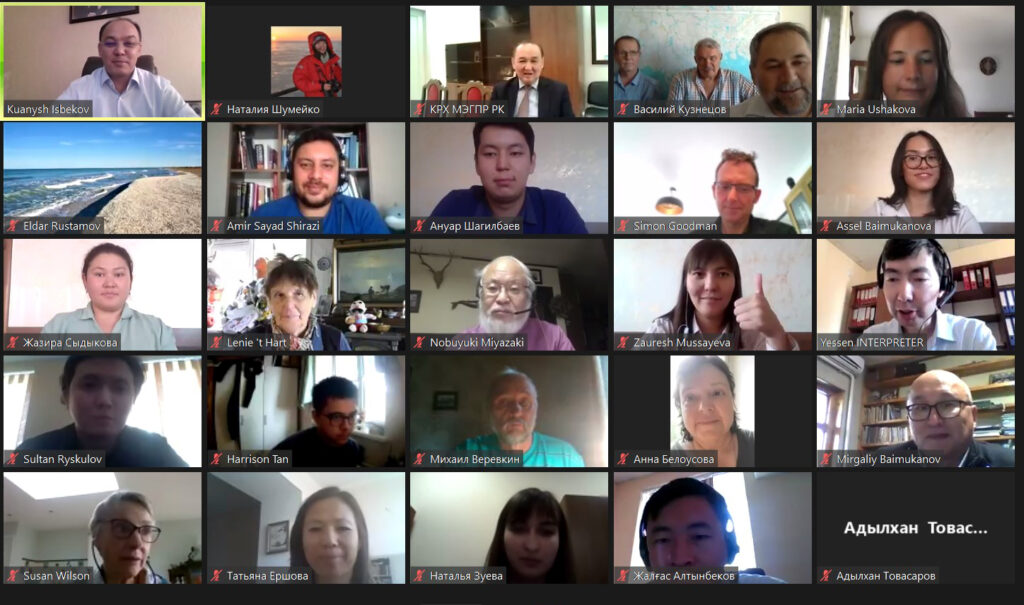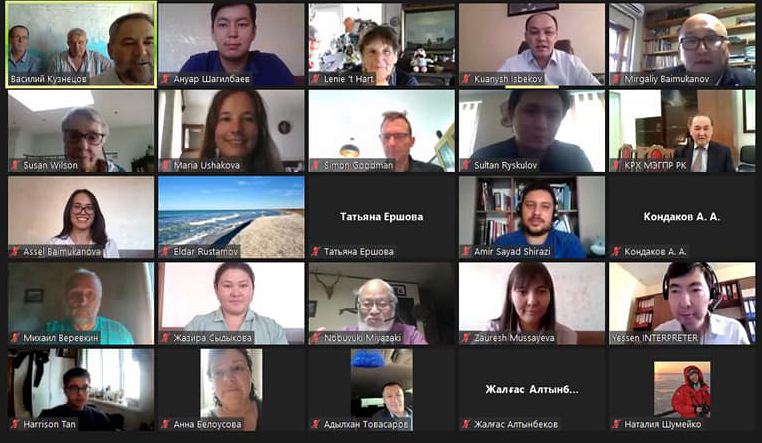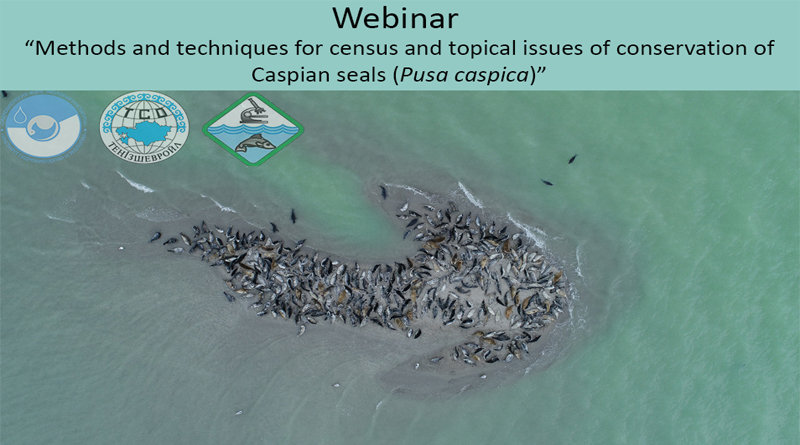International webinar on the Caspian seal
In August, 2021, II International Webinar “Research and preservation of the Caspian seal (Pusa caspica) population” on the topic of “Methods and Methodologies for Counting and Current Issues of Caspian Seal Preservation (Pusa caspica)” was held.
The webinar was attended by over 40 representatives of research, environmental, public organizations, agencies, foundations, oil and gas operators, ministries of Kazakhstan, Russia, Turkmenistan, Japan, the Netherlands and the United Kingdom. The organizers of the webinar – Kuanysh B. Isbekov, General Director of the Fisheries Research and Production Center of the Ministry of Ecology, Geology and Natural Resources of the Republic of Kazakhstan, Mirgaliy T. Baimukanov, Director of the Institute of Hydrobiology and Ecology, and Ayan K. Bakhiyanov, Deputy Chairman of the Fisheries Committee of the Ministry of Ecology, Geology and Natural Resources of the Republic of Kazakhstan – addressed the participants with a welcoming speech.
The methods and results of studies to assess the abundance and distribution of the Caspian seal were presented in the following reports: Monitoring of the Caspian seal population in the period from 2015 to 2020 (speaker Kuznetsov V.V.); Aerial surveys and population estimates of Caspian seals 2005-2012 (speaker Simon J. Goodman); Results of instrumental aerial surveys of Caspian seals in breeding haul-out sites in 2020 and 2021 (speaker Vladimir I. Chernook); Using multicopters to study the range and abundance of Caspian seals at island haul-outs (speaker Sultan Ye. Ryskulov). An analytical review on the sightings of the Caspian seal in the Volga River delta based on phenological observations of the Astrakhanskiy Nature Reserve from 1951 to 2016 was presented by Kirill V. Litvinov.
Reports on the impact of anthropogenic and natural factors on the status and mortality of the Caspian seal were made by: Simon J. Goodman (Estimating the magnitude of fisheries related mortality of Caspian seals, and the use of Caspian seal products in the illegal wildlife trade. What needs to be done to reduce fisheries related mortality of Caspian seals?); Tatyana S. Yershova (The physiological state of the Caspian seal as an indicator affecting its abundance); Nobuyuki Miyazaki (Conservation of Caspian seals in terms of biological characteristics, contamination of hazardous chemicals, influenza virus infection); and Irina V. Suvorova (Mass death of the Caspian seal on the Dagestan coast of the Caspian Sea in 2020).
The webinar presented methods for interpreting seal numbers at relatively small haul-out sites (speaker Susan C. Wilson), model-based methods for extrapolating seal counts based on habitat suitability (speaker Harrison Tan), logistic methods for organizing surveys of marine mammals (speaker Andrey A. Kondakov). Methodology for determining the age and studying the mortality of the Caspian seals was presented by Zhazira A. Sydykova.
The following reports were devoted to the conservation of the Caspian seal and its habitat: Results of the pilot project on the composition of marine debris in the ecosystem of the Caspian Sea (speaker Anuar U. Shagilbayev); Measures taken by the NCOC N.V. to protect the Caspian seal (speaker Samat M. Sarsengaliyev); Iran Caspian Seal Rehabilitation and Research Centre (speaker Amir Sayadshirazi); Information on the activities of the Center for the Study and Rehabilitation of the Caspian Seal in Aktau (speaker Adylkhan D. Tovassarov); Rescue and rehabilitation of seals (speaker Susan C, Wilson); Successful experience of interaction of world-class Russian environmental experts with local experts and residents of the Caspian region (Dagestan, Russia) for the Caspian seal protection (speaker Maria Ushakova); Designation of key Caspian seal habitat areas under the IUCN ‘Important Marine Mammal Areas’ initiative (speaker Simon J. Goodman); and Recommendations for the conservation of the Caspian seal population in the Kazakhstani part of the sea (speaker Mirgaliy T. Baimukanov).
(To download II International Webinar Agenda_7-18.08.2021).
As the participants of the webinar note, the Caspian seal is a transboundary species (its migration routes pass through the territorial waters of five states: Russia, Kazakhstan, Azerbaijan, Turkmenistan and Iran – note by KASPIKA). In this regard, studies of this endemic species, which is carried out by specialists from the Caspian and other countries, should be coordinated for an objective assessment of the Caspian seal population status. The status of the Caspian seal, as a rare and endangered species, recognized by all the Caspian countries, as well as the International Union for Conservation of Nature and the Convention on the Conservation of Migratory Species of Wild Animals (the Bonn Convention), requires the planning and implementation of coordinated, joint conservation measures. Coordination of research and environmental protection activities is especially relevant today – in the context of global climate change, growing anthropogenic pressure on the Caspian Sea, cases of mass mortality of seals for unknown reasons, due to IUU fishing, and etc.
Based on the results of the webinar, a consolidated document has been created, which includs proposals and recommendations for the studying and conservation of the Caspian seal population. (To download Final Document of the II International Webinar).
The international webinar was organized by the Institute of Hydrobiology and Ecology and the Fisheries Research and Production Center of the Ministry of Ecology, Geology and Natural Resources of the Republic of Kazakhstan at the initiative and support of the Ministry of Ecology, Geology and Natural Resources of the Republic of Kazakhstan and Tengizchevroil LLP. Information assistance from the Russian side was provided by KASPIKA Caspian Seals Conservation Agency and the Marine Mammal Council.



